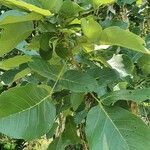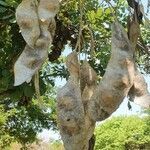A small to medium-sized tree with a rather sparse, rounded crown, reaching 10 m in height. Bark: creamy brown or light grey-brown, smooth to cracked and rather flaking; a red, sticky sap exudes from wounds. Leaves: with 1 or 2 pairs of opposite leaflets plus a large terminal one; leaflets oblong to ovate, 4-15 x 2.5-7.5 cm, grey-green, densely velvety when young, losing most of these hairs at maturity, 4-7 pairs of lateral veins; apex broadly tapering to rounded, with a fine, hair-like tip; base tapering to rounded; margin entire; petiolules short, petiole 3.5-9 cm long, velvety; stipules 3-6 mm long, falling early; stipels (like little horns) on the rachis at the base of the leaflets. Flowers: small, blue to violet, pea-shaped, sweetly fragrant, calyx covered with grey, velvety hairs; produced in terminal sprays up to 30 cm long, before the new leaves. Fruit: a flat, indehiscent pod, 7-15 x 2-3.5 cm, creamy grey, with a narrow rim sometimes wing-like.
A small to medium sized tree that loses its leaves. It grows 18 m tall. The crown is rounded. The bark is grey and has shallow cracks. It flakes off in scales. A red sticky sap comes from wounds. The leaves are 28 cm long. They have leaflets along the stalk with one at the end. There are 3-5 leaflets and the end leaflet is the largest. The leaflets are 13 cm long by 3-6 cm wide. They are narrowly oval and leathery. They are densely velvety when young. The flowers are in a loose branched group at the ends of branches. These are 10-25 cm long. The flowers are 9-11 mm long. The flowers are small and violet or blue. They are pea-shaped. The flowers have a scent. The fruit is a flat pod with 1-3 seeds. It is 8-18 cm long by 2-4 cm wide. It is leathery. The seed is 12-15 mm long by about 3 mm wide and kidney shaped. The covering is smooth and reddish-brown.
Leaves up to 28 cm long, imparipinnate; petiole 3.5–9 cm long; rachis 3–10 cm long, puberulous-glabrescent; petiolules 2–6 mm long; leaflets 3–5, the terminal much larger than the laterals; lamina (3)4–13(16.5) × 3–6(9) cm, ovate to elliptic or narrowly elliptic or oblong-obovate, rounded to obtuse or subacuminate-acute at the apex, rounded to broadly obtuse or cuneate at the base, leathery or subcoriaceous, light green on upper surface, paler and thinly tomentellous-glabrescent beneath; lateral nerves in 4–7 pairs, this and the reticulation slightly prominent beneath; stipules 3–6 mm long, falling early; stipels filiform, 1.5–4 mm long, often falling early.
Standard 10.5–12.5 mm long, broadly obovate, with nectariferous calluses towards the base, narrowly decurrent into the 2–2.5 mm long claw; wings oblong-obovate, 10–12 × 2.5–4 mm, auricle obtuse, claw 2.5–3.5 mm long; keel petals 9–11 × 3.5–6 mm, with subacute auricle, claw 2-3.5 mm long.
Pod 1–3-seeded, 8–18 × 1.8–3.5 cm, leathery, thinly velutinous, glabrescent, somewhat reticulate or smooth over the seeds, attenuate-acute at the apex, cuneate to narrowed at the base; stipe 1–4 mm long; wing along upper margin 1–3 mm broad.
Calyx 4–5 mm long, somewhat asymmetric at the base, thinly pubescent, the upper tooth-pair obtuse to shallowly lobed, the lateral teeth triangular, c.2 mm long, obtuse or rounded, the lower one narrowly triangular, acute, 2–4 mm long.
Young parts pale grey-subsericeous; branchlets slightly striate or terete, bark grey to brownish, thinly puberulous, glabrescent.
Inflorescence a terminal panicle 10–25 cm long, thinly pubescent-glabrescent; bracts c.1.5 mm long; bracteoles smaller, caducous.
Deciduous tree up to 18 m tall; crown rounded; bark greyish, shallow-fissured, flaking off in scales.
Ovary 3–5-ovulate, silky-pubescent; stipe c.1.5 mm long; style glabrous.
Seed 12–15 × 6–8 × 2.5–3 mm, reniform; testa reddish-brown, smooth.
Flowers 9–11 mm long; pedicels 2–5 mm long.
Stamen sheath 6–9 mm long.



